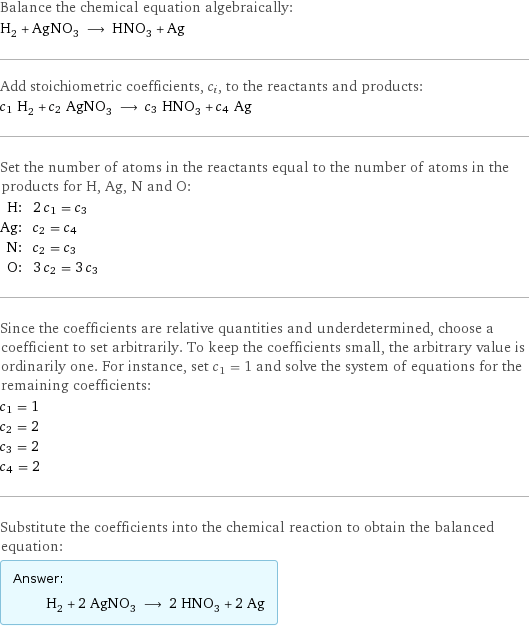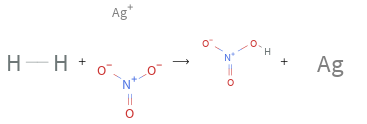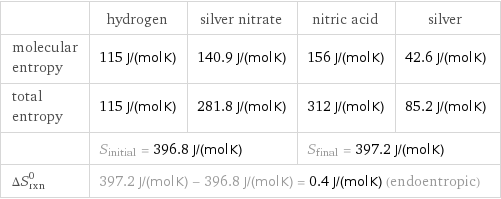Input interpretation

H_2 hydrogen + AgNO_3 silver nitrate ⟶ HNO_3 nitric acid + Ag silver
Balanced equation

Balance the chemical equation algebraically: H_2 + AgNO_3 ⟶ HNO_3 + Ag Add stoichiometric coefficients, c_i, to the reactants and products: c_1 H_2 + c_2 AgNO_3 ⟶ c_3 HNO_3 + c_4 Ag Set the number of atoms in the reactants equal to the number of atoms in the products for H, Ag, N and O: H: | 2 c_1 = c_3 Ag: | c_2 = c_4 N: | c_2 = c_3 O: | 3 c_2 = 3 c_3 Since the coefficients are relative quantities and underdetermined, choose a coefficient to set arbitrarily. To keep the coefficients small, the arbitrary value is ordinarily one. For instance, set c_1 = 1 and solve the system of equations for the remaining coefficients: c_1 = 1 c_2 = 2 c_3 = 2 c_4 = 2 Substitute the coefficients into the chemical reaction to obtain the balanced equation: Answer: | | H_2 + 2 AgNO_3 ⟶ 2 HNO_3 + 2 Ag
Structures

+ ⟶ +
Names

hydrogen + silver nitrate ⟶ nitric acid + silver
Reaction thermodynamics
Entropy

| hydrogen | silver nitrate | nitric acid | silver molecular entropy | 115 J/(mol K) | 140.9 J/(mol K) | 156 J/(mol K) | 42.6 J/(mol K) total entropy | 115 J/(mol K) | 281.8 J/(mol K) | 312 J/(mol K) | 85.2 J/(mol K) | S_initial = 396.8 J/(mol K) | | S_final = 397.2 J/(mol K) | ΔS_rxn^0 | 397.2 J/(mol K) - 396.8 J/(mol K) = 0.4 J/(mol K) (endoentropic) | | |
Equilibrium constant
![Construct the equilibrium constant, K, expression for: H_2 + AgNO_3 ⟶ HNO_3 + Ag Plan: • Balance the chemical equation. • Determine the stoichiometric numbers. • Assemble the activity expression for each chemical species. • Use the activity expressions to build the equilibrium constant expression. Write the balanced chemical equation: H_2 + 2 AgNO_3 ⟶ 2 HNO_3 + 2 Ag Assign stoichiometric numbers, ν_i, using the stoichiometric coefficients, c_i, from the balanced chemical equation in the following manner: ν_i = -c_i for reactants and ν_i = c_i for products: chemical species | c_i | ν_i H_2 | 1 | -1 AgNO_3 | 2 | -2 HNO_3 | 2 | 2 Ag | 2 | 2 Assemble the activity expressions accounting for the state of matter and ν_i: chemical species | c_i | ν_i | activity expression H_2 | 1 | -1 | ([H2])^(-1) AgNO_3 | 2 | -2 | ([AgNO3])^(-2) HNO_3 | 2 | 2 | ([HNO3])^2 Ag | 2 | 2 | ([Ag])^2 The equilibrium constant symbol in the concentration basis is: K_c Mulitply the activity expressions to arrive at the K_c expression: Answer: | | K_c = ([H2])^(-1) ([AgNO3])^(-2) ([HNO3])^2 ([Ag])^2 = (([HNO3])^2 ([Ag])^2)/([H2] ([AgNO3])^2)](../image_source/58487ec2faa71a619fe52f0525c6dfa4.png)
Construct the equilibrium constant, K, expression for: H_2 + AgNO_3 ⟶ HNO_3 + Ag Plan: • Balance the chemical equation. • Determine the stoichiometric numbers. • Assemble the activity expression for each chemical species. • Use the activity expressions to build the equilibrium constant expression. Write the balanced chemical equation: H_2 + 2 AgNO_3 ⟶ 2 HNO_3 + 2 Ag Assign stoichiometric numbers, ν_i, using the stoichiometric coefficients, c_i, from the balanced chemical equation in the following manner: ν_i = -c_i for reactants and ν_i = c_i for products: chemical species | c_i | ν_i H_2 | 1 | -1 AgNO_3 | 2 | -2 HNO_3 | 2 | 2 Ag | 2 | 2 Assemble the activity expressions accounting for the state of matter and ν_i: chemical species | c_i | ν_i | activity expression H_2 | 1 | -1 | ([H2])^(-1) AgNO_3 | 2 | -2 | ([AgNO3])^(-2) HNO_3 | 2 | 2 | ([HNO3])^2 Ag | 2 | 2 | ([Ag])^2 The equilibrium constant symbol in the concentration basis is: K_c Mulitply the activity expressions to arrive at the K_c expression: Answer: | | K_c = ([H2])^(-1) ([AgNO3])^(-2) ([HNO3])^2 ([Ag])^2 = (([HNO3])^2 ([Ag])^2)/([H2] ([AgNO3])^2)
Rate of reaction
![Construct the rate of reaction expression for: H_2 + AgNO_3 ⟶ HNO_3 + Ag Plan: • Balance the chemical equation. • Determine the stoichiometric numbers. • Assemble the rate term for each chemical species. • Write the rate of reaction expression. Write the balanced chemical equation: H_2 + 2 AgNO_3 ⟶ 2 HNO_3 + 2 Ag Assign stoichiometric numbers, ν_i, using the stoichiometric coefficients, c_i, from the balanced chemical equation in the following manner: ν_i = -c_i for reactants and ν_i = c_i for products: chemical species | c_i | ν_i H_2 | 1 | -1 AgNO_3 | 2 | -2 HNO_3 | 2 | 2 Ag | 2 | 2 The rate term for each chemical species, B_i, is 1/ν_i(Δ[B_i])/(Δt) where [B_i] is the amount concentration and t is time: chemical species | c_i | ν_i | rate term H_2 | 1 | -1 | -(Δ[H2])/(Δt) AgNO_3 | 2 | -2 | -1/2 (Δ[AgNO3])/(Δt) HNO_3 | 2 | 2 | 1/2 (Δ[HNO3])/(Δt) Ag | 2 | 2 | 1/2 (Δ[Ag])/(Δt) (for infinitesimal rate of change, replace Δ with d) Set the rate terms equal to each other to arrive at the rate expression: Answer: | | rate = -(Δ[H2])/(Δt) = -1/2 (Δ[AgNO3])/(Δt) = 1/2 (Δ[HNO3])/(Δt) = 1/2 (Δ[Ag])/(Δt) (assuming constant volume and no accumulation of intermediates or side products)](../image_source/075739c953e2da980ff808b2db366392.png)
Construct the rate of reaction expression for: H_2 + AgNO_3 ⟶ HNO_3 + Ag Plan: • Balance the chemical equation. • Determine the stoichiometric numbers. • Assemble the rate term for each chemical species. • Write the rate of reaction expression. Write the balanced chemical equation: H_2 + 2 AgNO_3 ⟶ 2 HNO_3 + 2 Ag Assign stoichiometric numbers, ν_i, using the stoichiometric coefficients, c_i, from the balanced chemical equation in the following manner: ν_i = -c_i for reactants and ν_i = c_i for products: chemical species | c_i | ν_i H_2 | 1 | -1 AgNO_3 | 2 | -2 HNO_3 | 2 | 2 Ag | 2 | 2 The rate term for each chemical species, B_i, is 1/ν_i(Δ[B_i])/(Δt) where [B_i] is the amount concentration and t is time: chemical species | c_i | ν_i | rate term H_2 | 1 | -1 | -(Δ[H2])/(Δt) AgNO_3 | 2 | -2 | -1/2 (Δ[AgNO3])/(Δt) HNO_3 | 2 | 2 | 1/2 (Δ[HNO3])/(Δt) Ag | 2 | 2 | 1/2 (Δ[Ag])/(Δt) (for infinitesimal rate of change, replace Δ with d) Set the rate terms equal to each other to arrive at the rate expression: Answer: | | rate = -(Δ[H2])/(Δt) = -1/2 (Δ[AgNO3])/(Δt) = 1/2 (Δ[HNO3])/(Δt) = 1/2 (Δ[Ag])/(Δt) (assuming constant volume and no accumulation of intermediates or side products)
Chemical names and formulas

| hydrogen | silver nitrate | nitric acid | silver formula | H_2 | AgNO_3 | HNO_3 | Ag name | hydrogen | silver nitrate | nitric acid | silver IUPAC name | molecular hydrogen | silver nitrate | nitric acid | silver
Substance properties

| hydrogen | silver nitrate | nitric acid | silver molar mass | 2.016 g/mol | 169.87 g/mol | 63.012 g/mol | 107.8682 g/mol phase | gas (at STP) | solid (at STP) | liquid (at STP) | solid (at STP) melting point | -259.2 °C | 212 °C | -41.6 °C | 960 °C boiling point | -252.8 °C | | 83 °C | 2212 °C density | 8.99×10^-5 g/cm^3 (at 0 °C) | | 1.5129 g/cm^3 | 10.49 g/cm^3 solubility in water | | soluble | miscible | insoluble dynamic viscosity | 8.9×10^-6 Pa s (at 25 °C) | | 7.6×10^-4 Pa s (at 25 °C) | odor | odorless | odorless | |
Units
